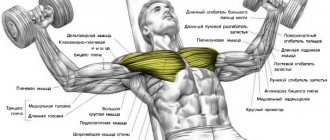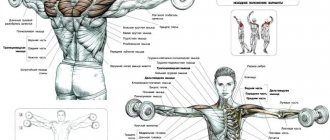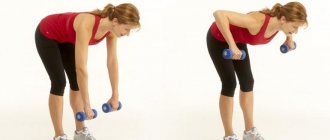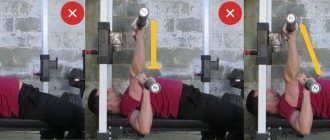The bench press is one of the most favorite exercises among gym goers. When someone finds out that you work out at the gym, the usual question is “how much do you bench press?”
The bench press is one of the mandatory exercises in powerlifting. All kinds of competitions are held on the bench press, when you need to press either the maximum weight for one time, or press a 70-100 kg barbell for the maximum number of times.
The bench press is one of the “big three” exercises: the squat, deadlift and bench press. These are the most powerful strength exercises with a barbell, in which a person is able to overcome very significant weights.
And, of course, the bench press is always included in the training programs of athletes of almost any specialization, from athletics to pure strength sports and martial arts.
What muscles does the bench press train?
The main work in the bench press, of course, is performed by the chest muscles, deltoids and triceps. However, no matter how you look at it, the bench press cannot do without the help of all other muscles. After all, you need to stabilize the position of your arms, shoulders, and whole body. Stabilizing muscles do most of the work.
Therefore, if you do the bench press seriously, the muscles of the whole body develop. But first of all, bench presses: triceps, chest muscles and deltoids.
Single dumbbell bench press
In fitness, the one-arm bench press is almost never used. This option requires additional activation of stabilizer muscles in order to maintain the position of the arm with the weight. The technique is commonly used by bench lifters. This option potentially increases strength performance.
Technique:
- Take the projectile in your hands and lie down on the bench. With your other hand, firmly hold the bottom of the bench to stabilize your body.
- Begin to slowly lower your hand until the pancake lightly touches your chest.
- Without pausing, press the weight back to the starting position without straightening your elbow.
The downside is increased trauma , so this exercise should be done with extreme caution.
Unlike other versions, when working with one hand, the lowering and raising of the projectile occurs slowly and under control, without jerking or inertia. Therefore, it is important to carefully select the weight of the burden .
What are the bench press variations?
The bench press can vary. There are quite a few variations of this great strength exercise.
Classic bench press
Simply lie down on a bench, plant your feet firmly on the floor for balance, and grab the barbell with a medium or wide grip. Perform flexion and extension of your arms until the bar touches your chest.
Powerlifting press
This is a special form of bench press. Performed with a strong deflection, on the bridge. But be sure to follow the rules: the upper back and buttocks must touch the bench.
This form of the press allows you to reduce the amplitude of the exercise and allows you to use the strongest body position. This option is used in powerlifting competitions in order to squeeze out as much weight as possible.
However, bench press lovers should be warned against thoughtlessly using this option. Without special training and development of flexibility, you risk serious injuries and sprains.
Bench press with limited amplitude
When performing a bench press, in this case the amplitude of movement of the barbell is artificially limited. For example, they put some kind of block on the chest so that the bar does not reach the chest, but stops 5-10 cm from it. This option makes sense, since the structure of muscle work and nerve impulses changes.
Another variation of the bench press with limited amplitude is the barbell bench press. Here you also do not have the opportunity to lower the barbell to your chest, since your elbows touch the floor first.
There are possible variations of the press in which the amplitude of the exercise is limited from above. That is, you do not straighten your arms to the end, stopping the barbell in the middle of the trajectory.
These presses must be performed under the supervision of a training partner.
Bench press in a power rack
A power rack is a special exercise machine with horizontal supports for the barbell. Using a power rack, you can set the supports to the desired height and perform a variety of strength exercises without the risk of being crushed by the barbell.
Performing bench presses in a power rack is one of the safest options if you don't have a partner nearby.
Smith Machine Bench Press
The Smith machine is a special simulator in which the barbell moves strictly along straight vertical guides. In this case, the bar can be fixed at any convenient height. The Smith machine eliminates the possibility of falling with the weight and allows you to safely press without the help of a partner.
As a rule, the Smith machine press is done on an incline bench.
Incline Bench Press
This variation of the barbell or dumbbell press is used to develop the upper parts of the pectoral muscles (clavicle area), which are difficult to develop with a regular bench press.
Many bodybuilding and fitness athletes do not do the usual version of the bench press at all, replacing it with the incline press.
Bench press on an incline bench
Bench presses with dumbbells
Unlike the barbell bench press, dumbbell presses have a number of advantages and disadvantages.
Benefits of dumbbell presses: Wider range of motion allowing for improved pectoral shape and flexibility. You can train with dumbbells at home. Dumbbell presses include many small stabilizer muscles in your workout.
Disadvantages: inability to perform bench presses with very heavy weights. It is impossible to perform the exercise with a dumbbell in each hand equal to half the weight of the barbell with which you are used to doing bench presses. You can usually perform the same number of repetitions with dumbbells weighing about 35-40% in each hand. This is due to the absence of a rigid biomechanical contour when working with dumbbells, which appears when working with a barbell. And this does not allow you to include all large muscles in the bench press. Efforts are dissipated to stabilize the position of the dumbbells.
Therefore, dumbbell presses are more appropriate in programs for general physical development and muscle mass. But more strength should be developed with a barbell.
Incline Dumbbell Press
Common Mistakes
Errors in technique, typical of many beginners, not only make dumbbell flyes virtually useless in terms of building muscle mass, but also significantly increase the risk of serious injury:
- Working with obviously unbearable weight. In this case, the elbows involuntarily go much lower than the shoulders, and the load on the ligaments and tendons increases sharply.
- Fully straightened arms. It provokes a shift of the load from the target muscle group to the shoulders and back.
- Excessively fast pace, work due to inertia. Raise the dumbbells with a slow, smooth, controlled movement so that your back and lower back do not suffer.
- Dumbbells thrown to the floor at the end of the approach, especially if done from the top point. There is a real risk of dislocating your shoulder or damaging ligaments.
- Inclusion of the head and neck in the process. Indeed, in professional athletes you can see something reminiscent of chin swings - they believe that the movement must be performed with the whole body. But for a beginner this is unacceptable.
- An attempt to make a bridge on a bench. Only the lower back comes off from her. The pelvis and shoulder blades should be pressed tightly against the surface of the bench.
- Shifting dumbbells from one vertical plane towards the face or legs. This is a basic flaw in the technique; you just need to learn to control the position of your hands.
Movements must be synchronized with breathing. Maximum physical effort (the phase of bringing the arms together with dumbbells) is performed while exhaling deeply.
To avoid unnecessary stress on muscles and tendons, it is important to choose the appropriate dumbbell weight.
The pace of raising the arms should be slow and smooth, without jerks or sudden movements.
The pelvis and shoulder blades should be pressed tightly to the surface of the bench
Errors when performing the bench press
The bench press looks very simple. He lay down on the bench, took the barbell and began to press. But this is only apparent simplicity. The exercise has a lot of nuances and subtleties.
Here are the most common mistakes when performing bench presses.
No warm-up approaches
Before performing any bench press, you should perform 1-3 warm-up sets. The higher the working weight, the more warm-up approaches you need to perform.
However, do not go too heavy on the number of repetitions and weight in the warm-up. It is enough to perform 5-6 repetitions with a weight of about 50-60% of the working one.
Wrong grip
The effectiveness of the bench press directly depends on a well-chosen grip. The optimal grip width for a person of average height is 80-95 cm between the palms. But this indicator may vary depending on the structure of the chest and the height of the athlete.
It is necessary to experimentally determine the optimal grip for yourself. As a rule, it immediately provides convenience when performing a bench press and allows you to perform it with the maximum weight possible for you.
Inadequately selected working weight
The weight of the barbell or dumbbells in the bench press should correspond to the development level of the athlete. If, in order to complete the approach, you are forced to distort the exercise technique or resort to various bodily tricks, it means that the weight was chosen incorrectly.
It should be comfortable to work in the bench press. All tension should be reduced to clearly overcoming the weight of the barbell, but not to attempts to hold it in your hands and not drop it on your head or chest. Working weights in the bench press should be increased gradually, according to the set of exercises.
No insurance
The bench press falls into the category of dangerous exercises, since there is always a risk that you will be crushed by the barbell in the last repetitions. Therefore, try to do the bench press in the presence of an assistant. Or at least strangers who can come to the rescue if necessary.
A buddy is especially important if you are doing a powerful strength program using significant weights on the bar.
Beating off the chest
When performing a bench press, many inexperienced and even experienced athletes often try to hit the bar on their chest as hard as possible in order to spring and squeeze the barbell.
Avoid this mistake to avoid injury and damage to the chest, spine and ribs. Follow the advice in the next paragraph.
No delay on the chest
When performing a bench press, you should pause the bar slightly at the lowest point when the bar touches your chest. This has at least two significant advantages.
You control the bar's trajectory, making the press safer.
Holding the bar makes your muscles work harder, especially in the lift-off zone. In addition, the rules of most strength competitions require holding the barbell on your chest. Otherwise, your bench press simply will not be counted.
By holding the barbell on your chest, you ensure a safe increase in your results. Your muscles, tendons and ligaments become stronger gradually. And this process should not be forced. If you use a chop, you will be able to work with a little more weight. However, if this is abused, the ligaments that cannot keep up with the strength of the muscles may fail, and injury will occur.
Performing a barbell press without locks
If you still have little experience in the bench press, it is better to use locks that keep the plates from rolling off. Otherwise, it may turn out that the last repetitions of the bench press will lead to a distortion of the position of the barbell, and the plates on one side will move out. This will cause the bar to jerk sharply in the opposite direction, possibly causing injury.
Common mistakes and recommendations for performing the exercise
The most common mistakes that beginners make:
- The exercise can be difficult at first, because the deltoid muscles, as we have already said, are initially small and rather weak, so many, when performing this exercise, actively engage the body in the work, swinging and giving impulse to squeeze the dumbbell more easily.
- The mistake is to perform the exercise in jerks or at high speed.
- Don't try to follow the movement of your hands by turning your head. Look straight in the mirror if you are not sure of the correct execution, but you do not need to turn your head. This can lead to cervical injuries.
Useful tips will help you perform the exercise as efficiently and safely as possible:
- There cannot be the same instructions for all athletes regarding wrist rotation and range of motion. If someone can bench press very high range of motion without any problem and has good results, your joint mobility may not allow you to do it as easily. Look for a position that is comfortable for you.
- Be sure to warm up your shoulder girdle before performing the exercise, otherwise there is a high risk of injury.
- If you have any problems with your back, especially your lower back, it is best to try doing the seated press.
- In order to prevent the body from staggering and swaying, it is necessary to keep your abs and back under control at all times and not relax them.
In conclusion, we note that although the standing dumbbell press can give the shoulders an impressive spherical shape that men so strive for, girls should not avoid this exercise. To build muscle mass and make your shoulders truly stand out, you need to lift heavy weights. If you perform the exercise with dumbbells up to 5 kg for 10-12 repetitions, you can make your shoulders chiseled and attractive.
Bench press, execution technique
Racks, barbell and bench
Use high-quality racks and a bench that prevent the bar from falling and tipping over when doing the bench press.
The bar should lie on the racks at a comfortable height for pressing, so that you can easily remove it and just as easily return it to the racks.
The bench should be neither too wide nor too narrow. You should be comfortable lying on it. Place a large towel on the bench to prevent slipping while doing the press.
Body and leg position
Lie down on the bench so that the bar of the barbell is approximately above your eyes. This way you will be able to fully control the position of the bar and see the racks when you need to return the bar to its place.
Lie down comfortably. Place your entire feet on the floor. Place them at least 60-70 cm wide to stabilize your body position. Control your body position with your legs.
Tighten your lower back and buttocks.
The head rests freely on the bench.
Many trainers advise bringing your shoulder blades together in the starting position. However, I do not recommend doing this, since you will exclude a number of necessary muscles from the exercise. Just lie naturally.
Grip
Grasp the barbell firmly, symmetrically, and with a fairly wide grip. Pay attention to the risks of the bar. They will ensure an even and symmetrical grip.
If you are sweating, it makes sense to treat your hands with chalk or magnesium. Thanks to this, the bar will not slip out of your hands at the most crucial moment. And your hands will not move apart under load.
Rod trajectory
Remove the barbell from the racks and hold it above your chest. Gently bend your arms, trying to lower the bar approximately in the nipple area. Don't lower the bar too high, too close to your neck. This is fraught with injury to the shoulder joints. Don't lower the bar too low, closer to your stomach. This way you won’t be able to overcome a large enough weight.
Accustom yourself to this basic trajectory. This is the most important part of your future bench press record - the exercise technique.
Performing a Bench Press
Lower the barbell to your chest and hold it as soon as the bar touches your body. But don’t relax, don’t let the barbell “flatten” you! A short delay and immediately an energetic press. Extend your arms. The bar should be at arm's length.
Work out the entire approach clearly and rhythmically, like clockwork, and place the barbell on the racks.
The bench press is described in more detail here.
Classic dumbbell press
The dumbbell bench press for girls and guys looks like a good replacement for lifting the barbell. The only difference is the ability to perform body movements with a higher amplitude.
The classic dumbbell bench press is performed as follows. Firmly grasp the dumbbells with your palms and place them on the bench. The sports equipment is thrown onto the chest. The dumbbells are deployed in one line. Slightly bend your back in the lumbar region, place your feet on the floor, and inhale to the full volume of your lungs.
As you exhale, lift the dumbbells upward from your chest. At the end point they stop for a few seconds. Tighten the pectoral muscles as much as possible. Then slowly lower the dumbbells to the starting position. A slight delay is performed at the bottom. The shoulder blades are brought together, which allows you to stretch the chest muscles.
How often to do the bench press
Different training systems recommend different frequencies. From three times a week to 1 time every 10-12 days.
The more weight you lift, the more days you have to rest gently after bench pressing.
The author of this article considers this schedule optimal. Do bench presses 2-3 times a week. But be sure to use the principle of load periodization. There should only be one really hard bench press workout per week. And the other 1-2 workouts should help maintain and develop the exercise technique. Such workouts are performed with medium and light weights with an increased number of repetitions.
For example:
Monday
Bench press: 5x5 (85% of maximum)
Thursday
Bench press: 4x12 (65% of maximum)
Recommendations
This is one of the most beneficial chest exercises. The dumbbell press on a horizontal bench, together with the regular barbell press, will provide a powerful workout for the entire group (work with dumbbells should always be after the barbell).
For decades in bodybuilding, the alternating incline bench scheme has proven itself to be excellent. For example, if you initially worked with a barbell on a horizontal surface, then it is better to use dumbbells at an angle and vice versa. Read more about the incline dumbbell press →
The number of repetitions and sets depends on the training regimen.
- In multi-rep cycles, 3-4 sets of 12-15 repetitions are usually done.
- In classic work for mass – 3-4 sets of 10 repetitions.
- To develop strength, a series of 5 sets of 6 repetitions is used (relevant only for men).
The dumbbell press for girls is no different in terms of technique. However, it is recommended to increase the number of repetitions to 12-20, especially when working with moderate weights. This is due to the higher endurance of the chest muscles in women. For muscle hypertrophy, it is recommended to work with a weight of 60-65% of 1RM in the “4*10” mode.
In general, many athletes “feel” their pecs much better when working with dumbbells. Also, this embodiment is ideal for drop sets and safe refusal approaches without the help of a partner.
And finally!
It seems obvious, but the bench press won't increase noticeably unless you train other large muscles. Your complex must include: squats with a barbell (at least once a week with a good load), deadlifts with a barbell (once a week), bent-over barbell rows, various basic exercises for the deltoids and triceps, as well as VPN exercises .
Examples of complete sets of exercises for increasing the bench press will be posted on the website in the near future.
Do bench presses and get stronger! Ask any questions you have in the comments.
Exercises with dumbbells for chest muscles. Top five. Close grip bench press with a barbell How to pump up your pectoral muscles










